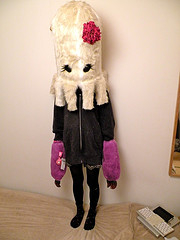This article originally appeared on Geek Feminism.
Warning: discussion of harassment and bullying. There is mention of self-harm and links to real-life bullying accounts at the end.
The substantive part of Corey’s comment which was not published on my “Why don’t you just hit him?” post was the following:
It’s like if you’re a parent of a bullying victim, and you find yourself repeatingignore it
So I’m supposed to treat women like they’re my children. Isn’t that extremely sexist and patronizing?
I didn’t reply to it initially because I think it’s a misreading: here’s the full paragraph of mine that Corey excerpted (emphasis as per the original post):
This is the kind of advice given by people who don’t actually want to help. Or perhaps don’t know how they can. It’s like if you’re a parent of a bullying victim, and you find yourself repeating “ignore it”, “fight back with fists” or whatever fairly useless advice you yourself were once on the receiving end of. It’s expressing at best helplessness, and at worst victim-blaming. It’s personalising a cultural problem.
I am, of course, saying that if one advises that women should or must hit back at harassers/attackers, then it resembles giving a bullying victim the same advice. Since the entire post is discussing why that advice is often bad advice, I’m fairly clearly not making the argument there that people should treat women as if those women are their children; I’m making the argument that they do, and they shouldn’t.
So much for that.
Except… that’s not quite right is it? Of course you should not treat unrelated adult women who complain of harassment at geek conferences like they are your children, because Corey and I would both tell you that’s sexist and patronising.
But the way we treat harassment victims and the way we treat child bullying victims have many parallels:
- we tell harassment victims it’s the price of admission to the awesome community; we tell bullying victims that it’s character building, the price of admission to adulthood
- we tell harassment victims they asked for it by wearing certain clothes or being a certain gender or not being a certain gender enough among many other things; we tell bullying victims that they’re so satisfying to tease, because of the way they react, that they are different from their bullies in some way and hiding that difference is the way to go
- we tell harassment victims that he’s basically a nice guy and he’s just a bit inexperienced with women, or with alcohol, or with both, and that his social skills need gentle nurturing; we tell bullying victims that their bullies are actually fine kids with good qualities that we don’t want to crush by labelling and punishing them as bullies
- we tell harassment victims that it’s a private matter that they could solve by ignoring it, or fighting back; we tell bullying victims that it’s… a private matter that they could solve by ignoring it, or fighting back
When they do report it, we also often leave them both with such failures that bullying victims and harassment victims both come to internalise the lesson that their persecution is a private matter, or at least that better keep it a private matter than tell anyone with power about it, because people with power will just back each other up.
(Should be obvious: I don’t support required reporting, or shaming people into reporting. I do support solving the problem when they do report.)
So harassment and bullying are the same class of problem, in fact they blur into each other very strongly: bullying of children and adults often includes harassment and assault (among the other forms of bullying, like sudden unexplained ostracism and you’re-our-friend-today-no-you’re-not yoyos and so on), an individual incident of harassment or assault might be the beginning of or part of a bullying relationship.
And neither can or should be solved by the victim, whether by ignoring, or by fighting back, or by changing themself into someone or something that the bully or harasser will approve of.
While, yes, adult harassment victims are not the same as child bullying victims, and they shouldn’t be treated exactly the same, here’s what I would argue: we should be treating them both a lot better. If you think that it would be extremely patronising if your chosen approaches to dealing with bullying in a child community resemble approaches to dealing with harassment in an adult community, then perhaps your understanding of the rights of children who are bullied isn’t bloody good enough.
It also really puzzles me, frankly, that geeks, who I think are a population that has disproportionate experience of being bullied at some point in their life, are so unwilling to recognise the dynamic and similar ones when it occurs in their culture.
Continue reading “Harassment and bullying”

 Ethics classes in special religious education time (SRE) are almost certainly going ahead in NSW, in 2011 at least.
Ethics classes in special religious education time (SRE) are almost certainly going ahead in NSW, in 2011 at least.


